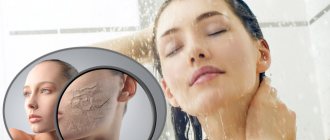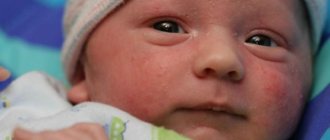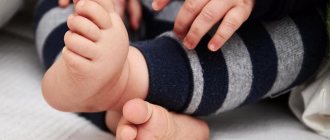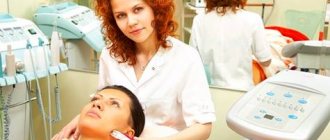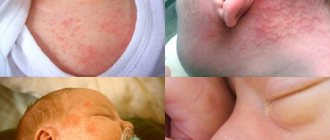How does heat urticaria manifest?
Each form is characterized by clear symptoms. The cholinergic type makes itself felt within 15–20 minutes after a provoking factor (stress, hot bath or shower, elevated air temperature, physical activity). Small pinpoint rashes no more than 3 mm in diameter appear in the form of nodules on the upper part of the body. They are surrounded by a wide ring of redness (hyperemia). The rash tends to merge.
Cholinergic urticaria rash
Skin itching is severe and bothers the patient throughout the entire period of the rash. Often the rash is accompanied by general symptoms such as nausea, drooling, and loose stools. In most cases, the symptoms of thermal urticaria stop within 30–50 minutes after the end of exposure to the provoking factor, but they can persist for several hours.
The local form is characterized by the formation of large bubbles after 3–5 minutes in the area of thermal influence. Skin changes persist for about an hour. Cases of a combination of heat and cold urticaria have been described.
The disease can manifest itself for several months or years and then disappear without a trace. Less commonly, the disease lasts for decades.
Forms of the disease
Doctors note that a person can be diagnosed with two forms of pathology. The first manifests itself in the form of an acute stage. It is characterized by the development of symptoms immediately after water, sweat or tears.
When the patient takes antihistamines, the symptoms quickly disappear. If you follow preventive measures, repeated relapses are excluded.
The skin on the face, neck and hands is very itchy when exposed to liquid
Chronic urticaria from water occurs in a third of patients. Symptoms may appear and intensify under the influence of negative factors. Signs can be observed to varying degrees depending on:
- level of sensitivity of the body;
- duration of contact with water;
- volume of liquid.
It is worth noting that water urticaria almost never leads to the development of anaphylactic shock and Quincke's edema.
Why does heat urticaria occur?
For the development of any form of illness, an allergic predisposition of the body is necessary. Some patients are diagnosed with other allergic diseases: food intolerance, atopic dermatitis, other types of urticaria.
In localized heat urticaria, histamine is directly released from mast cells upon local exposure to temperatures greater than 40ºC.
The cholinergic type is characterized by a general increase in body temperature after the action of provoking factors (physical activity, hot bath, stress, high air temperature). The thermoregulation center responds by releasing the neurotransmitter acetylcholine. This in turn stimulates the release of histamine from mast cells.
Heat allergy: what is the most effective treatment?
To quickly improve the condition of heat urticaria, you will need:
- follow a diet - avoid spicy, salty and too hot dishes, as well as fast food;
- dress correctly – choose clothes and shoes made from natural, “breathable” materials; avoid long walks in the hot season and protect your skin from direct sunlight;
- regularly use protective creams for the skin of the face, neck, hands and other exposed parts of the body;
- use antihistamines that will quickly get rid of the disease.
Diagnosis of heat urticaria
To determine the type and establish the causative factor, provocative tests are carried out.
To confirm the local form of thermal urticaria, apply a warm object (a glass of water heated to 40–46ºC) to the skin. The reaction is positive with the formation of bubbles and hyperemia. Another version of the test asks you to immerse your hand in water at the same temperature and note the appearance of the rash.
The cholinergic form is diagnosed when urticarial elements occur after being in a bath at a temperature of 40ºC or as a result of an exercise test. The effect is assessed after 5–30 minutes. Another test option is the intradermal administration of carbacholine, which is similar in composition and action to acetylcholine. The result is considered positive when bubbles of more than 15 mm appear.
Features of the disease
This form of urticaria can appear in both children and adults of any age and gender. It is especially often diagnosed in children, occurring chronically with periods of exacerbation and remission. Sometimes the disease disappears by adolescence due to hormonal changes in the body and never bothers you again. In other cases, urticaria occurs throughout life, causing significant discomfort.
This pathology is especially poorly tolerated by infants whose body thermoregulation has not yet been established.. In children, urticaria is often combined with other forms of allergies - to food, dust, detergents.
Women during menopause also often suffer from increased sensitivity to temperature. Against the background of hormonal imbalance, hot flashes are observed, which are accompanied by a sudden feeling of heat. It is because of this condition that the symptoms of urticaria develop, which manifest themselves even more intensely with additional exposure to a stress factor.
In a person of any age, excessive sensitivity to temperature effects is observed from a fever that lasts for several days. This occurs because the patient’s body is weakened by infection and medication. As a result, the immune system reacts with a rash and other unpleasant symptoms.
What therapy is indicated for heat urticaria?
In case of a local form of the disease, it is necessary to stop exposure to heat. If the itching is very painful, antihistamines are prescribed.
The cholinergic form also requires elimination, if possible, of the provoking factor. A cool shower and stopping physical activity alleviate the condition. A good effect is achieved by using ointments with atropine or belladonna extract, taking into account the mechanism of action.
For severe manifestations, antihistamines are indicated. The drug of choice for this form will be Hydroxyzine. It has both anticholinergic and antihistamine effects, and has antiemetic and antispasmodic effects. Considering the central mechanism of action on receptors, it causes sedation, which has a positive effect on the psycho-emotional causes of the development of generalized thermal urticaria. The drug is used in children from one year of age. The dosage is selected according to the patient's age.
For severe manifestations, treatment of thermal urticaria involves the use of hormonal ointments. Additionally, sedatives are used for sleep disturbances due to itching.
Preventive measures are aimed at limiting the influence of provoking factors. When taking a bath or shower, the water temperature should be such that it does not cause symptoms of the disease. You should, if possible, reduce physical activity and try to reduce the impact of stressful situations.
Treatment and general directions of therapy
Successful treatment of thermal urticaria depends on identifying the factors against which negative symptoms develop. The treatment of this form of allergic disease is in many ways similar to the treatment of cold and cholinergic urticaria.
General rules:
- refusal to visit the bathhouse, steam room, sauna;
- reducing physical activity to reduce sweating;
- treatment of chronic pathologies;
- suitable water temperature (warm, not hot) when showering and bathing;
- taking sedatives, reducing stress on the nervous system;
- proper nutrition, exclusion of highly allergenic foods from the diet;
- treatment of endocrine diseases, normalization of hormonal levels during menopause;
- treatment of allergic diseases that increase the risk of developing the thermal form of urticaria;
- change type of activity if stressful situations often arise at work;
- reducing contact with various types of irritants;
- initiation of therapy in children and adults when the first signs of an allergic reaction are detected.
Important! It is necessary to exclude the influence of high temperatures and stress, and to prevent increased production of acetylcholine. Only if these conditions are met is there hope for a positive result.
Medications
The main element of therapy is means for external use. Allergy ointments and creams with belladonna extract and atropine reduce the severity of symptoms of the disease.
Many antihistamines are ineffective in treating heat-type urticaria. For this reason, independent selection of medications does not give a positive result.
Doctors prescribe tablets and syrups for allergies:
- Lomilan.
- Cetrin.
- Claritin.
- Kestin.
- Erius.
- Zodak.
Treatment of problem areas with the following compounds gives a positive result:
- La Cree.
- Fenistil-gel.
- Advantan.
- Gistan.
Why does an allergy to the patch occur and how does it manifest itself? Read useful information.
For an overview and characteristics of effective hand allergy creams, see this article.
Go to the address and find out effective methods for treating face cream allergies.
Sedatives for frequent stress and high psycho-emotional stress:
- Karvelis.
- Novopassit.
- Valerian in tablets.
- Tenoten.
- Valemid.
- Afobazol.
- Persen.
- Tincture of motherwort and valerian.
- Soothing herbal tea.
Causes of heat rash
The causes of heat rash can be the following: prolonged exposure to the sun, clogged sweat glands, or a humid, hot climate during the acclimatization period.
Wet clothes can provoke skin rashes, so it makes sense not to use deodorants, since their action is aimed at clogging the sweat glands. When exposed to direct sunlight, the sweat glands narrow, causing them to become clogged, which is the cause of prickly heat. To eliminate skin rashes, you should prepare a bath in hot weather and add a weak concentration of potassium permanganate solution to it.
During the day, the skin should be constantly wiped with a wet towel, since its dryness is favorable for the occurrence of rashes. The towel should be soaked in a solution prepared from an infusion of calendula, string or chamomile. To prepare it, just pour 20 grams of each plant with boiling water in a volume of 250 milliliters.
Heat rash in a child
A heat rash in a child is a common occurrence, especially in the warm season. Most often it is associated with difficulty in the release of sweat from the sweat glands and may be accompanied by redness of the area of skin affected by the heat. Often the rash provokes the appearance of scaliness, spots and inflammation.
When exposed to heat, rash areas consisting of small white bubbles may form on a child's skin. In themselves, such rashes are not dangerous for the person on whose skin they appear, but they will cause some inconvenience. Their appearance is often accompanied by infections that provoke inflammation. In this case, an increase in temperature is observed when bubbles appear on the skin.
If a rash from heat occurs systematically in a child, a medical examination is necessary, since such a tendency may indicate chronic skin diseases. It often happens that skin rashes in children from heat are mistaken for a rash characteristic of another type of disease, so consultation with a pediatrician is necessary to exclude the possibility of lichen, chickenpox, and atopic dermatitis.
Heat rash in an adult
A heat rash in an adult can appear together with other diseases that have their own symptoms that are unique to them. It should be noted that by the appearance of the rash, it is impossible to immediately determine the reason for which disease it appeared, so a full medical examination is necessary with blood tests sent.
A rash on the body of an adult that occurs from heat can be localized in a variety of places, from the face to the toes and hands. However, as a rule, its location is strictly limited, that is, it can only appear in one place at a time. The appearance also varies - these can be bright red spots of large size, or light pink, smaller in area. A rash in the form of blisters, plaques, and nodules may also appear. It may be accompanied by itching and itching, or may not carry any unpleasant sensations at all.
Often people underestimate the seriousness of the problem, leaving the rash unattended, flattering themselves with the hope that it will go away on its own without any intervention on their part. The rash may disappear, but the reason for its appearance, which lies in the properties of the skin, will remain and the possibility of its reappearance will remain. Therefore, if there is a tendency for the rash to recur, it is necessary to seek help from a doctor to investigate the problem and practically eliminate it.
